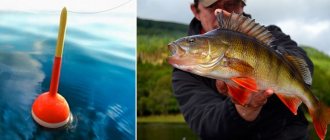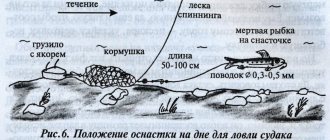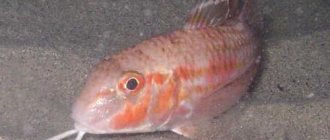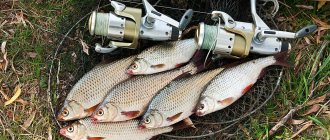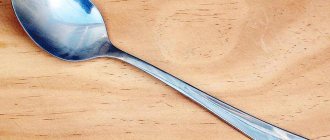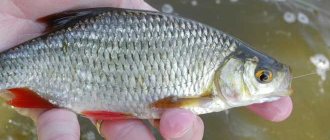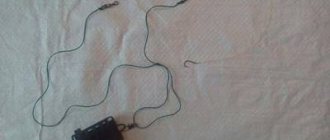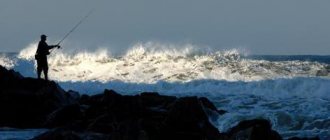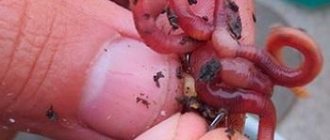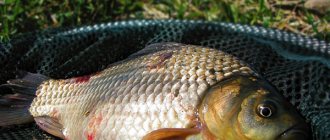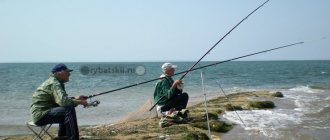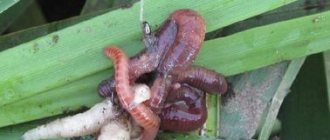All about catching red mullet. Tackle and fishing methods, places for fishing. Bait, feeding. Float, donka, match tackle, fishing from a boat.
The name “red mullet” came into Russian from the Turkish – barbunya, which comes from the Italian barbone, which means “big beard”. “Sultanka” is another name for this fish and, oddly enough, it is connected with a mustache, because it was believed that only sultans could have such a luxurious mustache. And, of course, “sultana” - because ordinary people were strictly forbidden to eat it, and all the fish went to the Sultan’s court. Red mullet is a very famous and famous fish. Pliny, Cicero, Seneca and Horace dedicated their works to the red mullet, who were fascinated by the ability of this fish to change its body color.
Red mullet is a genus of fish of the mullet family of the perciforme order and is represented by 4 species. Red mullet is a schooling fish in the sea, but schools of mullet are not numerous. The red mullet has a flattened, elongated body, which is unevenly colored in yellow-orange-red tones. The red mullet has a very large head, very unattractive, but the stunning coloring smoothes out this impression. The size of the red mullet is usually small, about 25-30 centimeters, maximum 45 cm.
The red mullet has two fairly long antennae hanging from its chin; they help it get food, mostly small invertebrates. These mustaches, in addition to their color, give the red mullet an interesting exotic look.
Red mullet can be a very controversial fish. It loves sandy or silty soft soil, but is sometimes found on rocky bottoms. In general, red mullet is a bottom dweller. You can usually find it at a shallow depth of 15-30 meters, but it is quite common at a depth of 100-300 meters. Since ancient times, fishermen have caught red mullet off the coast of the Mediterranean, Azov and Black Seas. But red mullet can be found not only in the basins of these seas. The Sultana lives along the eastern coast of the Atlantic Ocean - from the Canary and Azov Islands to Great Britain and Scandinavia.
about red mullet fish
Red mullet was very popular in Ancient Rome. The ancient Romans highly appreciated the taste of red mullet, and especially respected large fish. Rich people were ready to buy such red mullet for huge sums of money. They paid in silver, on a weight-for-weight basis. Such extravagance in connection with red mullet was so popular that even the ancient great Roman poet Horace mentioned it in his writings. Imagine what Horace himself wrote about the red mullet, who, by the way, was more inclined towards the small red mullet: “You praise, madman, you mullah for only one thing, that it weighs exactly three pounds... If enormity seduces, then how about a huge pike disgusts you so much?”
However, needless to say, the rich bought red mullet for the kind of money that could be used to buy a living slave. And all because the Romans were the first to learn how to breed red mullet in special pools. Some for food, and some for pleasure. These were simply huge aquariums and required the same effort and hassle to maintain them. After all, the water in the pool quickly deteriorated and it was necessary to bring fresh water from the sea. Martial even wrote about this: “The barvena (as the Romans called the red mullet) breathes in stagnant water, but becomes lazy and sleepy. Pour in fresh water and it will come back to life.” It was also a very expensive activity, so keeping red mullet in aquariums (or “piscinas”) was considered a sign of prestige and great wealth.
At the same time, there were people who believed that this was a reckless waste of money, that this was a frivolous hobby. The great Cicero treated such people with contempt and shamed the rich Romans of that time: “What an empty activity you Romans are carried away with! It’s a shame to watch, but others imagine themselves right in the sky if they manage to tame the sultanas to feed from their hands and swim when called.” But despite this, invited guests to rich houses never ceased to admire the beautiful spectacle and the dear owner’s ability to handle these orange fish. In addition, such an activity made it possible to feast on a live red mullet at any time, because it was, as they say, close at hand.
Interesting facts about sultana fish:
- This fish has a middle name - Sultanka. So she was named for her large and luxurious mustache, which only sultans can have.
- Red mullet was especially popular in Ancient Rome. There it cost fabulous money, and therefore only the richest people could afford to put it on their table. They paid for such fish in silver; they gave it as much as the fish itself weighed.
- In the distant past, before cooking, cooks brought red mullet in special containers to the dining room so that people could see their beauty with their own eyes.
A very unusual red mullet fish shimmering with silvery reflections; the photo cannot convey all its elegance. Only in air, their shine quickly disappears.
red mullet spawning
Puberty occurs in red mullets at 2-3 years of age. Spawning for red mullet begins in May and lasts until August at depths of 15 to 50 meters. Then the females lay eggs in portions, and after fertilization, the eggs rise to the upper layers of the water. After a few days, the larvae hatch from the eggs and begin to feed intensively. The juveniles feed on small animal organisms that inhabit the water column; their color is silver with a bluish-green tint, this color allows them to camouflage themselves from predators. And after 2 months, the fry swim to the shores, grow up, sink to the bottom and turn into real red mullet with their characteristic color and appearance, only small ones - 5-7 centimeters.
Lifestyle
The sultana fish rarely rises into the water column or swims long distances; it mainly moves along the bottom, on its fins and swarms in the bottom soil, in search of its usual food.
Watch in this short video a film about the everyday life of red mullet in the Black Sea
4.1. Reproduction - time and characteristics of spawning
Puberty occurs at the age of 2-3 years. Spawning from May to August. It lays eggs - in portions, in the amount of 3.5 - 90 thousand, after which the fertilized eggs rise to the surface, from which the larvae hatch after 2-4 days. After 2 months, the fry approaches the shore and, at the age of 6 cm, sinks to the seabed, where it continues its normal lifestyle.
4.2. Diet - what to eat
The red mullet feeds on small invertebrates that are found in mullet, mud and soft soil of the seabed. In rare cases, he may become coveted by a randomly found fish.
Short video “red mullet in search of food”
fishing for red mullet
Adult mullet swim to the shores when spring comes and swim into the depths only towards winter. Sometimes you can find red mullet in river mouths. The red mullet lives 10-15 years. Red mullet is almost always located near the shore, which means that if you have the skill, you can catch it. In spring, summer and autumn, any amateur angler can enjoy catching this red-orange miracle, but in winter the red mullet goes to greater depths.
Red mullet is caught on raw or boiled shrimp, on crab meat (only real, not imitation), and bites on mussel meat, seaworms and ordinary earthworms. Usually, a tourist fisherman has a difficult task - where to get fresh bait, because red mullet almost never takes artificial bait.
catching red mullet with shrimp
Of course, all tourist fishermen can’t wait to go fishing, so for those who are in a hurry, the easiest way out is to buy a bag of shrimp in a store or from selling grandmothers and aunties. One serving will be enough. You need to remember that red mullet almost never takes a spoiled bait, so you don’t need to buy a lot. You can catch shrimp yourself. It’s more interesting this way, and the bait will be fresh.
To catch shrimp you only need a landing net. But not just any one, look for a fine-mesh one and better folding one. Currently, stores are replete with an assortment of all kinds of fishing gear for every taste, size, color, etc. Therefore, searching for a landing net will not take much time. Based on his choice, we can say that a good landing net should have a long and very durable telescopic handle - this is the main criterion for a good purchase.
It’s not difficult to catch a shrimp on the Black Sea coast - you just need to run the landing net along an underwater rock or along the concrete base of a pier. Shrimp is a perishable product, so it is better to take a bucket with you to store the caught shrimp in water - they are quite tenacious in water, but without water they spoil very quickly. In extreme heat, a couple of hours is enough and the nozzle is damaged.
catching red mullet with mussels
Mussels are a bivalve mollusk. You need to look for mussels on the walls and piles of piers and breakwaters, on underwater rocks and rocks, on which they form entire colonies. To get mussels, you need a mask and great care when collecting them, because they have very sharp edges and can cause serious cuts. Mussels sit quite firmly on their bases, tearing them off is not as easy as it seems, so caution will not hurt here. It is better to store them the same way as shrimp - in a container with water - and better somewhere in a shady place, away from the sun. If you are going to catch red mullet all day, then the water at the bait needs to be changed in order to maintain the temperature and cleanliness.
In order to open the mussel, you will need a knife, which needs to be passed between the flaps, in their widest part. Thus, you cut the muscle that holds the two valves together; this muscle, or “leg,” is the densest place on the mussel, and it is your bait. Using a knife, you need to separate the loose parts, which can be used as bait. To catch a red mullet, a small piece of mussel is enough, so you need to cut the dense parts of the caught bait into small pieces and enjoy fishing.
catching red mullet with crab
Red mullet is excellent for catching on crab, but such bait is not at all easy to obtain. There are plenty of small crabs in the coastal area. They often crawl ashore to hunt insects, but fishermen should not hunt these crabs. The stones on the shore are very slippery, and the crabs are very agile. There is no point in chasing them, they will run away anyway, and you risk getting all sorts of injuries.
But there is a way out - a crab trap, which you can easily design yourself. Make a ring out of wire, and put a mesh on it (the wire ring should be about 20-30 centimeters). Attach three dense threads to this ring and tie them on top with a strong knot. Find a strong twine and secure it to the finished knot. When fishing, this string will pull the entire crab catcher. You will need a small stone for the load, which needs to be secured in the center of the mesh, and inside the mesh you should put bait (a piece of fish is perfect), which also needs to be secured. The finished crab catcher needs to be lowered to the bottom and wait. You can catch crabs from the pier by lowering the prepared tackle into the water. If you can’t do this, then you can simply go close to the shore at a shallow depth that is comfortable for you and place the crab catcher for about 15 minutes. This method of catching small crabs always works.
You can store crabs in a small but tall bucket so that your bait does not run away. It is not necessary to pour water into the bucket, since crabs can survive without water.
You also need to have pliers with you so that it is convenient to open the crab’s shell and get the long-awaited meat for bait. As usual, the meat is obtained from the claws, tentacles and from under the shell.
catching red mullet with a sea flea
The “sea flea” is a tiny crustacean that lives in the sand along the surf line. You need to get them there. This bait is good because it catches not only red mullet, but also an equally valuable fish – mullet. But since the “sea flea” is very small, it is very difficult to get it in the right quantity. But you need to be patient, because with such a bait you definitely won’t be left without a catch.
You need to bait the “sea flea” on a thin hook, several at a time. You can store your bait catch in a folded wet cloth.
catching red mullet with a sea worm
The sea worm is the most famous and easiest bait for catching red mullet. All types of fish in the Black Sea are caught with sea worms and, what’s even nicer, you can simply buy worms in fishing stores, markets, and all kinds of street tents. All local fishermen fish for sea worms, so if you are a tourist fisherman and don’t know where you can buy a worm, ask them, they will gladly tell you about places of sale and will even advise where they think is best.
But the fact is that, of course, you can get a sea worm yourself. But for a very long time. Who wants to waste their precious time. Therefore, right on the coast you can meet local “professionals” who will practically get a sea worm in front of you and sell it right away. In general, there are many mining options.
The sea worm is also called “nereid” and “sandworm”. This bait is quite dense and is mainly baited with a “stocking”, otherwise the small thing will gnaw off the worm quite quickly.
tackle for catching red mullet
Red mullet is the most interesting fishing object for fishermen on the Black Sea. Sometimes there are periods when red mullet appears in whole flocks off the coast of the Caucasus and Crimea. Then even the most inexperienced angler can please himself with a good catch of this tasty fish.
Red mullet is usually caught using float gear and a bottom fishing rod. Long casting is preferable, since this is sea fishing, which means great depths and waves. Bottom fishing rods must be very sensitive. The sea during fishing should be fairly calm and the current should be fairly weak. It is better not to skimp on hooks and leash lines for catching red mullet. And reels and rods can be cheaper and simpler. Nowadays, you can find good examples among inexpensive ones.
If you rely on European numbering, then the hook will fit at number 10 (5 according to domestic numbering). If you like to fish with a worm, then you need to choose a hook with a long shank.
It is better to use a transparent line, since this is sea fishing, a special “lead” line (0.14-0.16). As the main fishing line, many experienced fishermen recommend using “braid” from 0.15 and above, or a fairly thick monofilament line.
The length of the rod should be approximately 230-270 cm. When sea fishing, an increased load is placed on the reel, so you need to choose it carefully, and sea water can also have a negative effect on our reel. Therefore, it must be wear-resistant, reliable, have good traction, rotate easily and at the same time must have a reasonable price.
catching red mullet with a float rod
When fishing for red mullet, you can use a fly rod and fish with both a sliding (or moving) float and a stable one (blind rig). The float should be elongated, its antenna should be long enough and clearly visible, regardless of what type of equipment you choose. The mullet's bites are very gentle, so it is better to take floats with small weight capabilities, they will be more sensitive to the bites of this sunfish. It happens that the choice of float becomes key when catching red mullet.
When going fishing, ask the locals about the approximate depth of the place where you are going to go in order to choose the right gear. If the depth is up to 6 meters, then it is better to use a 1.5 g float, so you will feel the slightest bite. With a heavier float you will most likely miss bites, more or less depending on experience. But, you must admit, it’s unpleasant when the bait is eaten away or completely removed from the hook, and you didn’t notice anything. It’s a pity for both the time and the bait, especially if you got it yourself.
When fishing with a 5-6 meter rod at a depth of about 7 meters, it is better to attach a tiny shot at a distance of about 4 meters from the hook. The float with such equipment (it is better to take 2 g) will not move below this place, thereby relieving the fishing line from friction. When fishing with a moving float, the bait must be lowered to the very bottom, then raised alternately. Otherwise, you most likely won’t notice the bite. Whereas in fishing with a fixed float, the bait simply sinks to the bottom.
In general, a fixed and movable float has its positive and negative sides. For example, when using a moving float, signal sensitivity is low, the fisherman himself seems to feel these bites, and a fixed float gives an accurate picture of the bite. Or, when using a moving float, you can use shorter rods, and the rotation of the float, which means one of the main enemies in fishing - line twisting - is eliminated. But when using a fixed float, if the length of the fishing rod corresponds to the depth, there is a risk of rotation of the float, which leads to twisting of the line, which is very unpleasant. In general, the fisherman himself, with experience, chooses the most suitable and convenient option for him.
The leash should be the thinnest - 0.1-0.12 mm, it is better not to use anything thicker. The main line is 0.12-0.15 mm.
During a period when there are many tourists at sea, red mullet, like all fish, becomes suspicious. Therefore, for fishing it is better to choose places covered by high banks. And you need to use the simplest fixed float, since the sliding one is heavier and therefore less effective during this holiday period.
match tackle
Red mullet is often found in small areas far from the shore. In this case, a match fishing rod will help out the fisherman. This is a float tackle for long casting. The main difference from a regular float fishing rod is a special long-range float with an internal weight.
float for match tackle
It's better not to skimp on the float.
A cheap one will fly poorly and tangle the equipment. It happens that a flock of red mullet feeds on underwater heights, where the depth is about 2-3 m. Then they use a blind rig, and as a sinker a tiny “olive” or 2-3 pellets close to the float.
blind match tackle
The leash should be 15-20 cm. Hook No. 12-14, always with a long shank. The nozzle should balance 3-5 cm from the bottom. With a fixed rig on a match fishing rod you can fish by “pulling”. But if the depth at the fishing spot is more than 3-4 meters, then it is necessary to use a sliding float equipment.
match tackle with sliding float
light picker
At a great distance from the shore, a light picker-quivertip with a sensitive tip and thin equipment is ideal for catching red mullet. This is a bottom fishing rod, similar in installation to a feeder. You will need a rod from 2.2 to 3.5 m, with replaceable tips that act as a bite alarm.
rod for picker rig
It is better to choose a spinning reel with a spool of 4-5 cm and which holds at least 100 m of main line 0.2-0.25 mm. Leashes should be no more than 0.15-0.17 mm. Small hooks (No. 12-16), bait - pieces of shrimp meat, crab pulp, sea earthworms, sea flea.
The best places for catching red mullet with pickerel are in the estuary areas of the sea, as well as in the belt of pebbly or sandy-muddy soils
It is better to take from 1 to 3 sliding “olives” as a sinker. This depends on the weight of the individual sinkers, the diameter of the main line and the casting distance.
To stop the olives, you need to install a swivel at the end of the main line, to which a 20 cm long leash is attached using a loop.
Red mullet often eats the bait, so it is preferable to use 2 leashes. The second leash, 22-25 cm long, is placed above the sliding “olives” so that the hook does not touch the bottom.
Experienced fishermen advise that the perfect version of such equipment is when two leashes are located below the sinker, and they are spread with a special wire mustache (yoke). The main thing is to choose a distance so that the hooks do not touch or catch each other when casting.
Fishing can be either passive or active. The main thing is to know what the bottom is in the selected area, since when dragging (during active fishing) in the presence of a large number of algae, hooks and breaks of the equipment are possible.
catching red mullet from a boat
Often in spring or autumn, red mullet can gather in large schools in shallow waters far from the shore. Therefore, it is advisable to use a boat and a regular fly rod with a blind rig for catching red mullet to catch red mullet. But we must remember that it is impossible to stay away from the shore in the dark.
catching red mullet on a donk
To fish with a donkey, you need to take a fishing line 1 m long, to which is attached a swivel with a carabiner and a sliding sinker, which is fixed with two pellets, as well as 2-3 leashes with hooks. You need to use small hooks No. 10-14. It will be better if the tip of the hook is slightly bent to the side, and you can put a piece of red cambric on the shank of the hook. It has been noticed that this attracts red mullet well from a fairly large distance.
At the end of May and beginning of June, you can catch red mullet simply with an ordinary worm. During this period, the red mullet begins to eat intensely, and it takes any moving bait.
Catching red mullet on a bottom tackle with a fly rod is an interesting and exciting activity. It happens that a red mullet pecks and pecks and then goes quiet. But as soon as you “look” for the red mullet, it starts pecking again. And to do this, you need to tease the red mullet, “play” with the tackle along the bottom, and also raise and lower the rod, moving it little by little to the side. A bite is guaranteed.
Red mullet is a very cautious fish, so fishermen have noticed that the bite is much more intense if the tip of the hook is hidden at the very tip of the bait, so that even with the slightest hook, it digs into the red mullet’s lip.
When fishing for red mullet on a bottom, the sinker should be placed in front of one or two hooks (there is no need to use more hooks). Leads should be taken with a diameter of 0.15-0.17 mm and a size of 8-10 cm. The sinker should rest against the locking knot or pellet. The second stop knot is made on the main line 0.25-0.3 mm 5-6 cm above the sinker.
Having made the cast, you need to tighten the fishing rod so that the sinker rests against the lower locking knot, then easily loosen it so that it sags easily. When a red mullet takes the bait, it swims with it away from the sinker or suddenly wants to rip the worm off the hook. Meanwhile, the fishing line slides freely in the sinker, and the locking knot hooks the fish.
The sinker should be sliding, 40-50 g. The color should be whitish so that the bite is fearless. With such equipment, the mullet bite is noticed by the tension and weakening of the fishing line. If the fisherman misses the bite, the red mullet will most likely hook itself. But when pulling out the fish, be careful, as the red mullet resists strongly and may sometimes escape. In general, there are a large number of rigging methods, choose to your taste, rely on your skills and experience
If you are in a circle of fishermen, then ask, be interested - maybe there will be someone talkative, or boastful. From experienced sea fishermen you can get, in addition to knowledge, skills in catching red mullet. You can learn interesting fishing methods, because the locals know the landscape better, adapt to all conditions - in a word, they live there.
With match gear.
Red mullet often stays in areas far from the shore. In this case, a well-balanced match fishing rod will be indispensable. Sometimes flocks of mullet feed on underwater hills, above which the depth does not exceed 2-3 m. Then they use a blind rig, and as a sinker a small “olive” corresponding to the float test or two or three pellets installed side by side - close to the leash.
See also: WHAMES OF AUTUMN CARSP. IS IT WORTH GOING TO SAZAN IN AUTUMN?
The length of the leash is 15-20 cm. Hook No. 12-14 with a long shank. The nozzle should be 3-5 cm from the bottom. With a fixed rig on a match fishing rod, you can fish with a forced retrieve, i.e. by pulling.
If the depth at the fishing site with a match fishing rod exceeds 3-4 meters, then a sliding float rig is usually used.
bait for red mullet
The success of catching red mullet depends on finding the habitats of the schools. However, it should be taken into account that on the sandy bottom the sultana moves a lot in search of food. To keep discovered fish in place and attract new schools, bait is sometimes used.
It can be prepared from a mixture of animal feed with the addition of bottom sand. For example, they take two or three kilograms of mussels, pound them on flat stones into small particles, mix them with a small amount of finely chopped earthworms and add soil in a ratio of 1:3. All this is mixed in a large container and then periodically thrown into the fishing area. Fishing efficiency can be increased by feeding fish. Very often, when fishing vertically, Yalta fishermen throw pieces of bottom silt into the water, in which sea worms were stored - the turbidity and smell attract the sultana.
Crushed shrimp are also a very interesting bait option, although with such feeding there is a high risk of attracting a flock of small perch, horse mackerel and whiting (“haddock”) to the fishing site, which will ultimately make fishing unbearable. In any case, feeding at sea is an effective and promising method, but, unfortunately, little developed and poorly developed in practice.
How to fish on the bottom?
Sultanka is one of the favorite fishing objects for residents of the coastal cities of the Black Sea region. It is definitely worth pointing out that there are restrictions on catching this fish. The size of the catch should not be less than 8.5 cm. Bottom and float gear are used to catch red mullet. As with most sea fishing, the rigs can be quite simple.
Fishing with a float rod
Features of using float gear for catching mullet depend on the fishing conditions and the experience of the fisherman. For coastal fishing, rods for “blind” equipment with a length of 5-6 m are usually used.
For long casts, match rods are used. The choice of equipment is very diverse and is limited by fishing conditions, and not by the type of fish.
As already noted, the equipment can be made quite simple. As in any float fishing, the most important element is the correctly selected bait and bait.
Some fishermen believe that there is no need to use lures and bait to catch the sultana. It is worth noting that this is not entirely true.
In any case, the use of animal bait brings only positive results.
Fishing with bottom gear
Red mullet responds well to bottom fishing rods. It is very convenient to use traditional gear, such as an elastic band or a hook.
Fishing with bottom fishing rods, including feeder and picker, is very convenient for most, even inexperienced fishermen. They allow the fisherman to be mobile on the reservoir, and, due to the possibility of targeted feeding, to quickly “collect” fish in a given place.
Feeder and picker, as separate types of equipment, currently differ only in the length of the rod. The basis is the presence of a bait container-sinker (feeder) and replaceable tips on the rod.
The tips change depending on the fishing conditions and the weight of the feeder used. The bait for fishing can be any bait, in the case of the sultana, of animal origin.
This fishing method is available to everyone. The tackle does not require additional accessories and specialized equipment.
It is worth paying attention to the choice of feeders in shape and size, as well as bait mixtures. This is due to sea fishing conditions and the food preferences of local fish.
The sultana is distributed along the entire eastern coast of the Atlantic and adjacent seas. The fish populations of the Mediterranean and Black Seas are very famous.
In the Sea of Azov, red mullet is not found so often. There are especially many in the eastern part of the Black Sea.
As already mentioned, there are species of mullet that live in the North Atlantic to the Baltic Sea. In addition, there is a multiband red mullet that inhabits the Indian and western Pacific Oceans.
In a situation where the mullet is in no hurry to peck, you can stir it up a little or tease it. To do this, the tackle must be carefully moved along the bottom.
This must be done as follows: the bait mounted on the bottom fishing rod is slightly raised, taken a little to the side and lowered again. And so several times in a row.
If all other conditions for catching red mullet are met, and the place and time of fishing are chosen correctly, then after such a technique the red mullet will not resist and will definitely bite.
It is worth noting that despite the small timidity of the fish, it is distinguished by considerable caution. This must be remembered when placing bait on a hook.
Small in size, it should be stuck into the very edge of the worm so that the mullet does not fall off at the slightest hook. Photos in various specialized literature for anglers show approximate gear that needs to be chosen for catching sultana.
where to catch red mullet
Now let’s touch on some “tactical aspects” of fishing. To achieve success, it is necessary, first of all, to have a good knowledge of the red mullet fishing waters. Knowing the “points” and their features is the key to success. If the place you have chosen does not live up to expectations, you need to get involved in an active search for fish, and the better you know the water area, the easier it will be for you to do this. If a red mullet does not bite here and now, this does not mean that the fish has “closed its mouth tightly” (after all, sea fish, unlike freshwater fish, are always relatively active, the main thing is to find their accumulation).
“Running” along the piers or along the beaches can often dramatically improve your fishing results. You just need to run wisely... At the same time, it is useful to analyze the state of the sea and know the dynamics of water temperature. So, if at high air temperatures there was a strong surge and the water cooled sharply, for example, to 12°C, then the mullet will most likely go to the very shore in shallow water, where the water will quickly warm up to temperatures comfortable for the fish. If the water on the beaches has already warmed up to 20°C and above, then it makes sense to fish in deep places, from piers, port piers or stone embankments (where long casting to depth often helps).
From the boat.
Fishing from a boat at sea is limited to daylight hours: it is prohibited to be away from the shore in the dark. The boat or motorboat is placed on guy ropes with two anchors, which should be 20-30 m from the vessel so that the ends do not interfere with casting.
Often, especially in spring and autumn, red mullet concentrates in large numbers over shallow banks remote from the shore, where it can be caught from a boat using a regular fly rod with a blind rig.
If you find yourself on a large school, you should expect a confident bite. In this case, the test of the float can reach up to 5-6 g. And with floats of increased test, it is, of course, more convenient to fish at sea, because they are more stable on the wave.
Some fishermen, having discovered a school of red mullet standing at great depths, manage to catch it using onboard fishing rods, designed according to the winter fishing principle - for them, special holder nests must be made at the stern or on board. Such a fishing rod is equipped with a reel with a spool of sufficiently large diameter (so that you can quickly reel in the line when fishing at depths of up to 25 m).
As a bite alarm, it is most effective to use a sensitive nod made of a metal or mylar plate. Instead of a jig, a 15-centimeter leash with a small hook is tied through a swivel at the end of the main line.
To attract fish, the fisherman moves the bait, periodically slowly raising it from the bottom to 30-50 cm. In addition to red mullet, other small Black Sea fish that stay in schools near the bottom also bite well on such gear.
See also: Why is there fish in the rivers in Germany, but not in Russia?
nutritional and beneficial properties
Red mullet has a high protein content and very little fat, so it is almost impossible to gain weight from this fish. At the same time, red mullet is quite high in calories - 100 g of fish contains 150 kcal. But these calories only look threatening. In fact, red mullet fats contain polyunsaturated fatty acids, which are very beneficial for the nervous and cardiovascular systems. And the calorie content of protein does not bring extra pounds, but adds strength to the human body.
Dishes made from mullet allow you to quickly restore strength, and for pregnant women, young children and the elderly, red mullet is an indispensable product, as it contains a large amount of vitamins AA, PP, group B, C, macro- and microelements.
Red mullet is a delicate, delicious fish. Knowledgeable people say that by eating this goldfish, you can quickly restore your strength. Red mullet meat is very tasty, which is probably why the use of red mullet is endless. They say that fresh red mullet is almost impossible to spoil. Housewives of the Mediterranean cook fish soup from it, bake it in the oven, fry it in a frying pan, on the grill; no favorite spices will spoil the taste of red mullet. Red mullet is also good as an appetizer. It is used to make aspic, salt it, dry it, and smoke it.
A characteristic feature of red mullet is that it does not have bile, so it is not necessary to gut it, which greatly simplifies the process of preparing it. Red mullet liver is especially tender, soft, aromatic and, of course, very much appreciated by lovers of this fish.
In Mediterranean restaurants, the small mullet, about 20 cm, is more respected. The meat of the “young” mullet is considered more tender and tasty. Among all the fish of the Mediterranean Sea, red mullet is considered the most expensive and valuable fish delicacy.
To find red mullet, tourists have to try hard. It is usually found in restaurants and cafes at resorts in Russia and Ukraine, where red mullet dishes always come first. Basically they cook mullet with the head, but gutted. You can find on the menu there stewed mullet in white wine with spices and grape leaves, fried mullet in crushed breadcrumbs in melted butter (this is the recipe that was appreciated in Ukraine and Russia) and many other gourmet recipes.
In stores you can find red mullet canned in oil, which, by the way, is also a very tasty thing. But true connoisseurs and fish lovers will look for fishermen who often sell red mullet in markets. Risky for health, but tastier. And fishing tourists will definitely find out how and where to catch red mullet, so that they can later enjoy its freshest taste.
red mullet recipes
deep-fried mullet
Ingredients:
- kilogram of red mullet
- vegetable oil for deep frying
- bunch of parsley
- 2 lemons
- 100 g flour
- salt pepper
cooking
If the mullet is small, then you don’t have to gut it. Rinse with cold water and dry with a towel. Pour vegetable oil into a deep fryer or deep frying pan and heat to approximately 180 degrees. Salt and pepper the fish and roll in flour. Immerse the red mullet in hot oil for 2-3 minutes until golden brown. Remove and place on a napkin to remove excess oil.
Briefly dip coarsely chopped parsley into the deep fryer and remove with a slotted spoon. Place the fish on a dish, sprinkle with fried parsley, garnish with lemons, cut into 4 parts.
Spanish fried red mullet
For 6 servings you will need:
- 6 red mullet 200 – 250 gr.
- 100 ml olive oil
- 1 onion
- clove of garlic
- 400 g tomato
- bunch of parsley
- flour for dredging red mullet
- salt
- ground black pepper
- thyme
- Bay leaf
